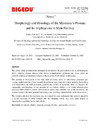Please use this identifier to cite or link to this item:
https://accedacris.ulpgc.es/handle/10553/114253
| Title: | "Notes" Morphology and Histology of the Mysticete’s Prostate and Its Implications in Male Fertility | Authors: | Suarez Santana, Cristian Manuel Fernández Rodríguez, Antonio Jesús Caballero Cansino, María José Rivero Santana, Miguel Antonio Arbelo Hernández, Manuel Antonio |
UNESCO Clasification: | 240110 Histología animal | Issue Date: | 2021 | Journal: | Aquatic Science and Technology | Abstract: | The global whale population has dramatically declined in the past centuries due to anthropogenic abuse, whereas, climate change, ship strikes, entanglements, pollution, and water debris are currently making an enormous impact on the recovery of all whales on the planet. The prostate is recognized as the only male accessory gland in odontocete cetaceans, and prostatic pathologies have been recently described as very common in these animals. But nothing is reported about the male accessory gland in any species of mysticete. Here, we describe the topography and histology of the prostate of two baleen whales: a fin whale (Balaenoptera physalus) and a Bryde's whale (Balaenoptera edeni) and conclude that in the mysticetes, the prostate displays the same general morphologic and histologic characteristics as in odontocetes. The prostatic gland of the mysticete may be a target for many pathogens that wants to spread by a sexual transition to other animals and the offspring which may have great impact on reproductive capability for the individuals | URI: | https://accedacris.ulpgc.es/handle/10553/114253 | ISSN: | 2168-9148 | DOI: | 10.52941/ast.v10i1.21 | Source: | Aquatic Science and Technology [ISSN 2168-9148], v. 10(1), p. 12-18 |
| Appears in Collections: | Artículos |
Page view(s)
56
checked on Feb 4, 2023
Download(s)
9
checked on Feb 4, 2023
Google ScholarTM
Check
Altmetric
Share
Export metadata
Items in accedaCRIS are protected by copyright, with all rights reserved, unless otherwise indicated.
